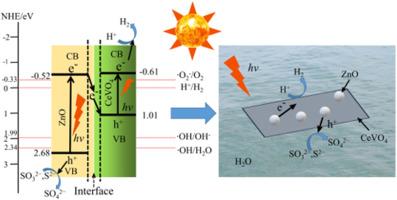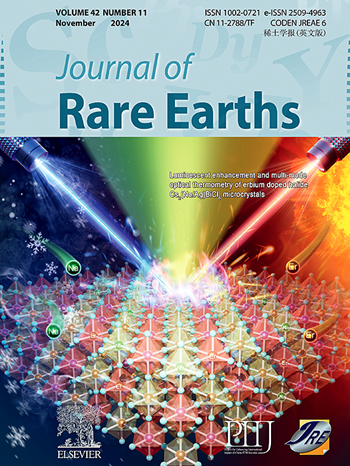A Z-scheme heterojunction constructed by ZnO/CeVO4 for highly active photocatalytic hydrogen production
IF 7.2
1区 化学
Q1 CHEMISTRY, APPLIED
引用次数: 0
Abstract
Photocatalytic hydrogen production is one of the most promising ways to obtain sustainable hydrogen energy. However, it is constrained by low energy conversion efficiency, which is due to the fast recombination of photogenerated electrons and holes, the low utilization rate of the visible light of the solar spectrum, and the severe photo corrosion of semiconductor photocatalyst. The construction of semiconductor heterojunction is not only beneficial to the separation of photogenerated carriers in photocatalysts, but also effective to broaden the range of light harvest by introducing narrow bandgap semiconductors. In this paper, a heterojunction photocatalyst ZnO/CeVO4 was obtained by simple mild physical method. The Z-scheme heterostructure of ZnO/CeVO4 is conducive to the strong electron interaction, the enlarged light trapping range, the promoted separation and migration of photo carriers, and the high redox properties. Compared with the pure ZnO and CeVO4 catalysts, the photocatalytic efficiency of ZnO/CeVO4 is higher, and the optimal hydrogen production rate reaches 1289 μmol/(g·h). This work affords a simple mild method to construct a Z-scheme CeVO4 based photocatalysts, which show high active photocatalytic H2 production performance.

ZnO/CeVO4构建的z型异质结用于高活性光催化制氢
光催化制氢是获得可持续氢能最有前途的途径之一。但由于光生电子与空穴复合速度快、太阳光谱可见光利用率低、半导体光催化剂光腐蚀严重等原因,其能量转换效率较低。半导体异质结的构建不仅有利于光催化剂中光生载流子的分离,而且可以通过引入窄带隙半导体来有效地扩大光收获范围。本文采用简单的温和物理方法制备了一种异质结光催化剂ZnO/CeVO4。ZnO/CeVO4的Z-scheme异质结构有利于强电子相互作用,扩大光捕获范围,促进光载流子的分离和迁移,并具有较高的氧化还原性能。与纯ZnO和CeVO4催化剂相比,ZnO/CeVO4的光催化效率更高,最佳产氢率达到1289 μmol/(g·h)。本研究为构建具有高活性光催化制氢性能的z型CeVO4光催化剂提供了一种简单温和的方法。
本文章由计算机程序翻译,如有差异,请以英文原文为准。
求助全文
约1分钟内获得全文
求助全文
来源期刊

Journal of Rare Earths
化学-应用化学
CiteScore
8.70
自引率
14.30%
发文量
374
审稿时长
1.7 months
期刊介绍:
The Journal of Rare Earths reports studies on the 17 rare earth elements. It is a unique English-language learned journal that publishes works on various aspects of basic theory and applied science in the field of rare earths (RE). The journal accepts original high-quality original research papers and review articles with inventive content, and complete experimental data. It represents high academic standards and new progress in the RE field. Due to the advantage of abundant RE resources of China, the research on RE develops very actively, and papers on the latest progress in this field emerge every year. It is not only an important resource in which technicians publish and obtain their latest research results on RE, but also an important way of reflecting the updated progress in RE research field.
The Journal of Rare Earths covers all research and application of RE rare earths including spectroscopy, luminescence and phosphors, rare earth catalysis, magnetism and magnetic materials, advanced rare earth materials, RE chemistry & hydrometallurgy, RE metallography & pyrometallurgy, RE new materials, RE solid state physics & solid state chemistry, rare earth applications, RE analysis & test, RE geology & ore dressing, etc.
 求助内容:
求助内容: 应助结果提醒方式:
应助结果提醒方式:


